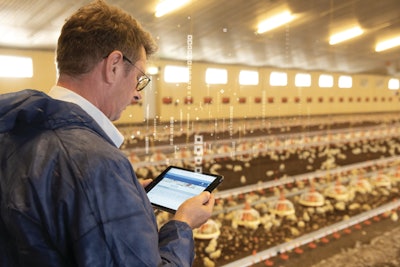
Although there are early adopters, the agricultural sector – and poultry in particular – has some way to go to catch up when it comes to the use of digital technology compared to many other industries. Yet, digital farming tools offer many opportunities for poultry businesses and can provide solutions for a growing number of issues.
Why aren’t digital adoption rates higher?
Some of the main challenges the poultry sector faces when looking to adopt a more digital approach include a lack of digital infrastructure (mainly internet connectivity); IT knowledge and the required skills; initial set-up costs; users being unwilling to share data; and the threat to traditional jobs.
Internet connectivity is, perhaps, the most significant barrier to digital readiness. It is often an issue for farms worldwide as they are off-the-grid when it comes to high-speed broadband services due to their rural locations.
The implementation of transformative 5G technology should help to overcome this issue as it will facilitate increased upload and download speeds and better interaction with Internet of Things (IoT) enabled devices. It should also reduce set-up costs. In addition, better connectivity will provide the opportunity to deliver training remotely and can help to address the skills gap.
I expect the roll-out of 5G to quickly accelerate this year and believe it will lead to a step change in communications. This can help push the poultry industry forwards and provide producers with the opportunities to boost production.
As well as maintaining the flock itself, digital technology can be used to monitor emissions and share data, via secure, neutral platforms. Used correctly, a digital farming approach can bring farmers and end-consumers closer together as the production chain becomes more transparent.
The global population is increasing and along with that growth comes greater demand for agricultural products, especially poultry. Meeting that demand efficiently is a challenge compounded by a lack of farm workers, the high age demographic of many in the sector, along with a need to produce food more sustainably and with greater transparency and traceability.
Growing need
New approaches and strategies are needed to generate a better understanding of farming and identify and implement improvements. Increasing digitalization can help to meet challenges by collecting and combining data from different sources and time periods and allowing it to be analyzed in a more detailed way, more quickly.
Digital tools, including sensors, screening technology and artificial intelligence can improve animal welfare, and reduce disease outbreaks and production losses by introducing early warning systems and a ‘whole flock’ management approach. This allows producers to take preventative actions rather than reacting when a problem becomes apparent in the more traditional ways. This improves efficiency and raises standards.
Benefiting the whole supply chain
I believe that digitalization is the future of poultry production. The increasing use of data- and science-based solutions in animal nutrition and farming is the basis of the precision livestock farming (PLF) approach, which builds upon the practices of: sustainable animal nutrition, animal health and animal farming. By combining decades of science-based expertise with the relevant data pools by intelligent software algorithms, it is possible to interlink previously disconnected areas of the protein value chain.
The poultry industry may be currently missing out on digital, but I think the situation will change as the benefits become more accessible and better understood.

















